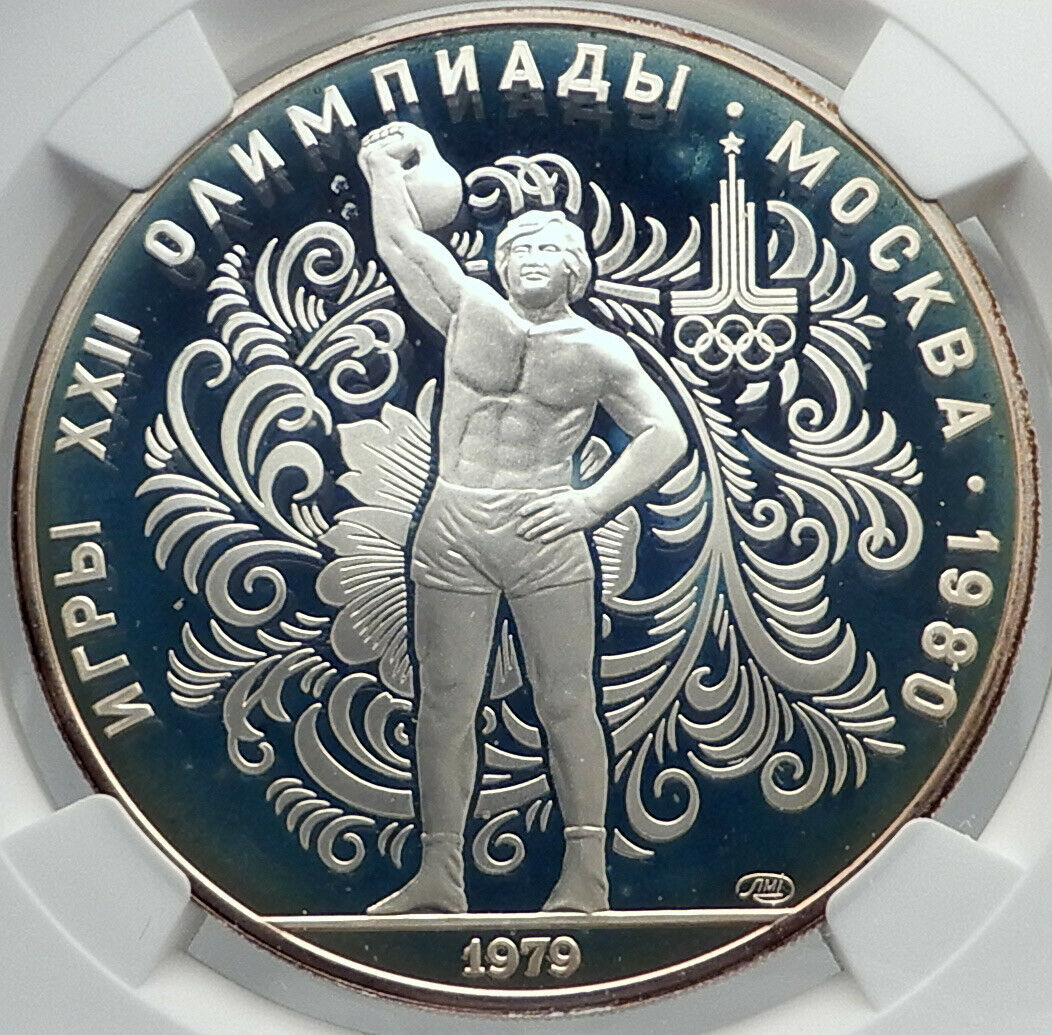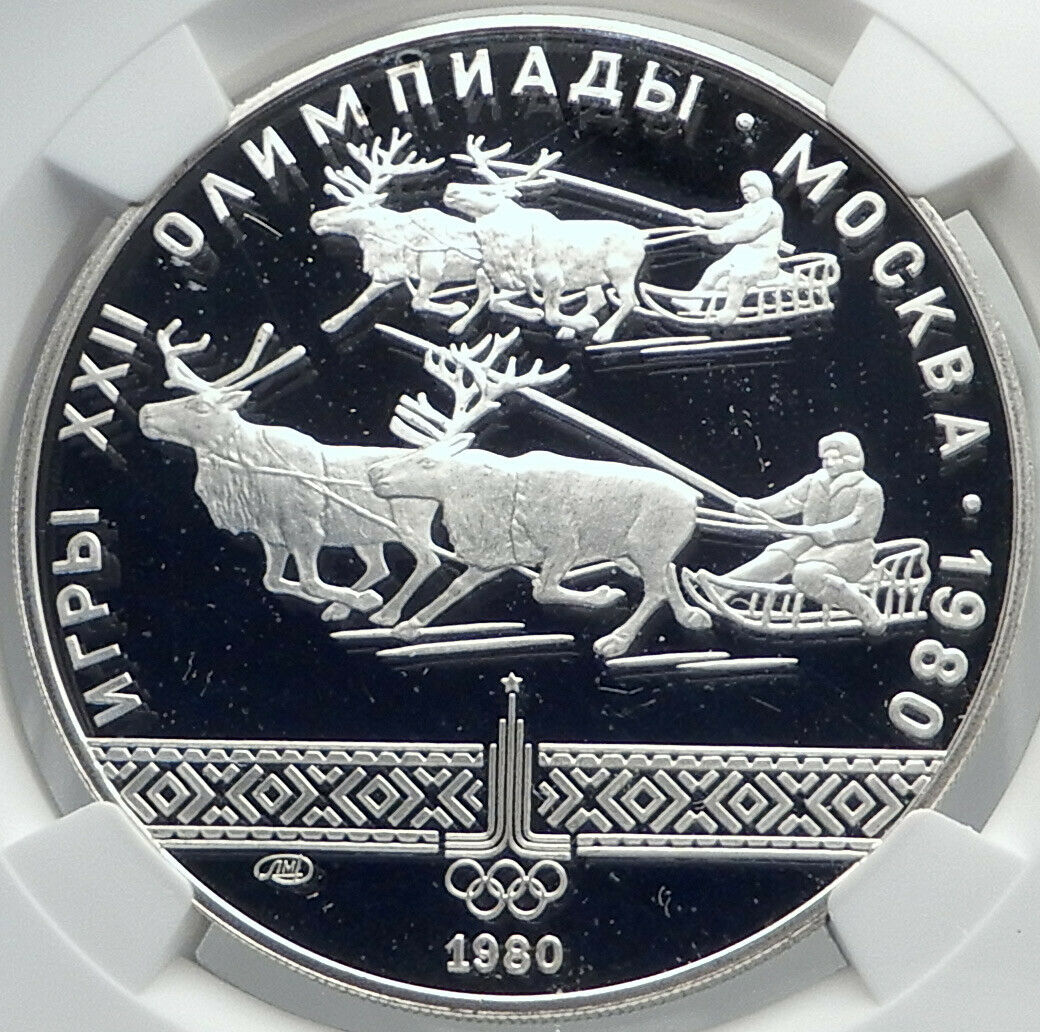|
Russia – USSR Russia – Union of Soviet Socialist Republics
1980 Proof Summer Olympics, Moscow Commemorative Issue
1979 Proof Silver 10 Roubles 39mm (33.30 grams) 0.900 Silver (0.9574 oz. ASW)
Reference: Y# 169
ИГРЫ XXII ОЛИМПИАДЫ · МОСКВА · 1980 ЛМД 1979, Two teams playing volleyball in front of building, the logo for the summer Olympics in the field to left.
СССР 10 РУБЛЕЙ, The coat-of-arms of the Soviet Union.
You are bidding on the exact item pictured, provided with a Certificate of Authenticity and Lifetime Guarantee of Authenticity.
 The 1980 Summer Olympics, officially known as the Games of the XXII Olympiad (Russian: И́гры XXII Олимпиа́ды, tr. Igry XXII Olimpiady), was an international multi-sport event held in Moscow, Soviet Union, in present-day Russia. The 1980 Summer Olympics, officially known as the Games of the XXII Olympiad (Russian: И́гры XXII Олимпиа́ды, tr. Igry XXII Olimpiady), was an international multi-sport event held in Moscow, Soviet Union, in present-day Russia.
The 1980 Games were the first Olympic Games to be staged in Eastern Europe, and remain the only Summer Olympics held there, as well as the first Olympic Games to be held in a Slavic language-speaking country. They were also the first Olympic Games to be held in a socialist country, and the only Summer Games to be held in such a country until 2008 in Beijing, China. These were the final Olympic Games under the IOC Presidency of Michael Morris, 3rd Baron Killanin.
Eighty nations were represented at the Moscow Games – the smallest number since 1956. Led by the United States at the insistence of US President Jimmy Carter, 66 countries boycotted the games entirely because of the Soviet invasion of Afghanistan. Some athletes from some of the boycotting countries (they are not included in the list of 66 countries that boycotted the games entirely) participated in the games under the Olympic Flag. This prompted the Soviet-led boycott of the 1984 Summer Olympics.
 The Union of Soviet Socialist Republics (USSR, Russian: Союз Советских Социалистических Республик, tr. Soyuz Sovetskikh Sotsialisticheskikh Respublik, abbreviated СССР, SSSR), also known as the Soviet Union (Советский Союз), was a constitutionally socialist state that existed on the territory of most of the former Russian Empire in Eurasia between 1922 and 1991. The Union of Soviet Socialist Republics (USSR, Russian: Союз Советских Социалистических Республик, tr. Soyuz Sovetskikh Sotsialisticheskikh Respublik, abbreviated СССР, SSSR), also known as the Soviet Union (Советский Союз), was a constitutionally socialist state that existed on the territory of most of the former Russian Empire in Eurasia between 1922 and 1991.
The Soviet Union had a single-party political system dominated by the Communist Party. Nominally a union of Soviet republics, of which there were 15 after 1956, with the capital in Moscow, de facto the Soviet Union was a highly centralized state with a planned economy. The security agency KGB actively oversaw much of the Soviet society.
The union was founded in December 1922, when the Russian SFSR, which formed during the Russian Revolution of 1917 and emerged victorious in the ensuing Russian Civil War, unified with the Transcaucasian, Ukrainian and Belorussian SSRs. After the death of Vladimir Lenin, the first Soviet leader, power was eventually consolidated by Joseph Stalin, who led the country through a large-scale industrialization with command economy and political repression. During World War II, in June 1941, the Soviet Union was attacked by Germany, a country it had signed a non-aggression pact with. After four years of warfare, the Soviet Union emerged as one of the world’s two superpowers, extending its influence into much of Eastern Europe and beyond. The Cold War, a global ideological and political struggle between the Soviet Union and its satellites from the Eastern Bloc on the one side and the United States and its allies on the other side, which the Soviet bloc, hit by economic standstill, ultimately lost, marked the post-war period. In the late 1980s the last Soviet leader Mikhail Gorbachev tried to reform the state with his policies of perestroika and glasnost, but the Soviet Union ultimately collapsed and was formally dissolved in December 1991 after the abortive August coup attempt. Since then the Russian Federation is exercising its rights and fulfilling its obligations.
_-_Crimea_disputed.svg/220px-Russian_Federation_(orthographic_projection)_-_Crimea_disputed.svg.png) Russia (Russian: Росси́я, tr. Rossiya), also officially known as the Russian Federation (Russian: Российская Федерация, tr. Rossiyskaya Federatsiya), is a country in Eurasia. At 17,125,200 square kilometres (6,612,100 sq mi), Russia is the largest country in the world by surface area, covering more than one-eighth of the Earth’s inhabited land area, and the ninth most populous, with over 144 million people at the end of March 2016. The European western part of the country is much more populated and urbanised than the eastern; about 77% of the population live in European Russia. Russia’s capital Moscow is one of the largest cities in the world; other major urban centers include Saint Petersburg, Novosibirsk, Yekaterinburg, Chelyabinsk, Nizhny Novgorod, Ufa and Kazan. Russia (Russian: Росси́я, tr. Rossiya), also officially known as the Russian Federation (Russian: Российская Федерация, tr. Rossiyskaya Federatsiya), is a country in Eurasia. At 17,125,200 square kilometres (6,612,100 sq mi), Russia is the largest country in the world by surface area, covering more than one-eighth of the Earth’s inhabited land area, and the ninth most populous, with over 144 million people at the end of March 2016. The European western part of the country is much more populated and urbanised than the eastern; about 77% of the population live in European Russia. Russia’s capital Moscow is one of the largest cities in the world; other major urban centers include Saint Petersburg, Novosibirsk, Yekaterinburg, Chelyabinsk, Nizhny Novgorod, Ufa and Kazan.
Extending across the entirety of Northern Asia and much of Eastern Europe, Russia spans eleven time zones and incorporates a wide range of environments and landforms. From northwest to southeast, Russia shares land borders with Norway, Finland, Estonia, Latvia, Lithuania and Poland (both with Kaliningrad Oblast), Belarus, Ukraine, Georgia, Azerbaijan, Kazakhstan, China, Mongolia and North Korea. It shares maritime borders with Japan by the Sea of Okhotsk and the U.S. state of Alaska across the Bering Strait.
The East Slavs emerged as a recognizable group in Europe between the 3rd and 8th centuries AD. Founded and ruled by a Varangian warrior elite and their descendants, the medieval state of Rus arose in the 9th century. In 988 it adopted Orthodox Christianity from the Byzantine Empire, beginning the synthesis of Byzantine and Slavic cultures that defined Russian culture for the next millennium. Rus’ ultimately disintegrated into a number of smaller states; most of the Rus’ lands were overrun by the Mongol invasion and became tributaries of the nomadic Golden Horde in the 13th century. The Grand Duchy of Moscow gradually reunified the surrounding Russian principalities, achieved independence from the Golden Horde, and came to dominate the cultural and political legacy of Kievan Rus’. By the 18th century, the nation had greatly expanded through conquest, annexation, and exploration to become the Russian Empire, which was the third largest empire in history, stretching from Poland on the west to Alaska on the east.
Following the Russian Revolution, the Russian Soviet Federative Socialist Republic became the largest and leading constituent of the Union of Soviet Socialist Republics, the world’s first constitutionally socialist state. The Soviet Union played a decisive role in the Allied victory in World War II, and emerged as a recognized superpower and rival to the United States during the Cold War. The Soviet era saw some of the most significant technological achievements of the 20th century, including the world’s first human-made satellite and the launching of the first humans in space. By the end of 1990, the Soviet Union had the world’s second largest economy, largest standing military in the world and the largest stockpile of weapons of mass destruction. Following the dissolution of the Soviet Union in 1991, twelve independent republics emerged from the USSR: Russia, Ukraine, Belarus, Kazakhstan, Uzbekistan, Armenia, Azerbaijan, Georgia, Kyrgyzstan, Moldova, Tajikistan, Turkmenistan and the Baltic states regained independence: Estonia, Latvia, Lithuania; the Russian SFSR reconstituted itself as the Russian Federation and is recognized as the continuing legal personality and sole successor state of the Soviet Union.[30] It is governed as a federal semi-presidential republic.
The Russian economy ranks as the twelfth largest by nominal GDP and sixth largest by purchasing power parity in 2015. Russia’s extensive mineral and energy resources are the largest such reserves in the world, making it one of the leading producers of oil and natural gas globally. The country is one of the five recognized nuclear weapons states and possesses the largest stockpile of weapons of mass destruction. Russia is a great power as well as a regional power and has been characterised as a potential superpower. It is permanent member of the United Nations Security Council, as well as a member of the G20, the Council of Europe, the Asia-Pacific Economic Cooperation (APEC), the Shanghai Cooperation Organisation (SCO), the Organization for Security and Co-operation in Europe (OSCE), and the World Trade Organization (WTO), as well as being the leading member of the Commonwealth of Independent States (CIS), the Collective Security Treaty Organization (CSTO) and one of the five members of the Eurasian Economic Union (EEU), along with Armenia, Belarus, Kazakhstan and Kyrgyzstan.
|





 The 1980 Summer Olympics, officially known as the Games of the XXII Olympiad (Russian: И́гры XXII Олимпиа́ды, tr. Igry XXII Olimpiady), was an international multi-sport event held in Moscow, Soviet Union, in present-day Russia.
The 1980 Summer Olympics, officially known as the Games of the XXII Olympiad (Russian: И́гры XXII Олимпиа́ды, tr. Igry XXII Olimpiady), was an international multi-sport event held in Moscow, Soviet Union, in present-day Russia. The Union of Soviet Socialist Republics (USSR, Russian: Союз Советских Социалистических Республик, tr. Soyuz Sovetskikh Sotsialisticheskikh Respublik, abbreviated СССР, SSSR), also known as the Soviet Union (Советский Союз), was a constitutionally socialist state that existed on the territory of most of the former Russian Empire in Eurasia between 1922 and 1991.
The Union of Soviet Socialist Republics (USSR, Russian: Союз Советских Социалистических Республик, tr. Soyuz Sovetskikh Sotsialisticheskikh Respublik, abbreviated СССР, SSSR), also known as the Soviet Union (Советский Союз), was a constitutionally socialist state that existed on the territory of most of the former Russian Empire in Eurasia between 1922 and 1991._-_Crimea_disputed.svg/220px-Russian_Federation_(orthographic_projection)_-_Crimea_disputed.svg.png) Russia (Russian: Росси́я, tr. Rossiya), also officially known as the Russian Federation (Russian: Российская Федерация, tr. Rossiyskaya Federatsiya), is a country in Eurasia. At 17,125,200 square kilometres (6,612,100 sq mi), Russia is the largest country in the world by surface area, covering more than one-eighth of the Earth’s inhabited land area, and the ninth most populous, with over 144 million people at the end of March 2016. The European western part of the country is much more populated and urbanised than the eastern; about 77% of the population live in European Russia. Russia’s capital Moscow is one of the largest cities in the world; other major urban centers include Saint Petersburg, Novosibirsk, Yekaterinburg, Chelyabinsk, Nizhny Novgorod, Ufa and Kazan.
Russia (Russian: Росси́я, tr. Rossiya), also officially known as the Russian Federation (Russian: Российская Федерация, tr. Rossiyskaya Federatsiya), is a country in Eurasia. At 17,125,200 square kilometres (6,612,100 sq mi), Russia is the largest country in the world by surface area, covering more than one-eighth of the Earth’s inhabited land area, and the ninth most populous, with over 144 million people at the end of March 2016. The European western part of the country is much more populated and urbanised than the eastern; about 77% of the population live in European Russia. Russia’s capital Moscow is one of the largest cities in the world; other major urban centers include Saint Petersburg, Novosibirsk, Yekaterinburg, Chelyabinsk, Nizhny Novgorod, Ufa and Kazan.




